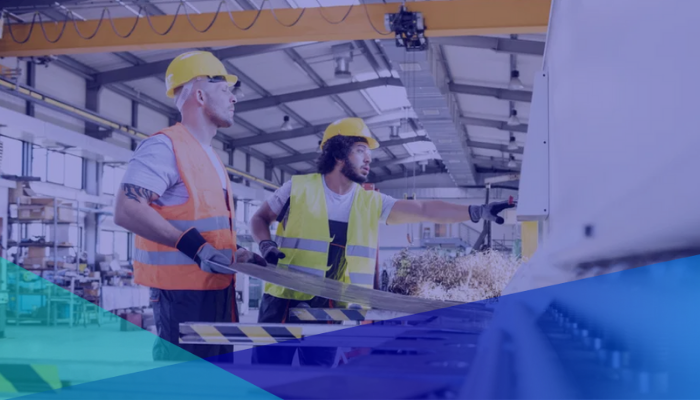
COVID-19 dealt an unprecedented blow to the global supply chain. Almost overnight, demand skyrocketed in some sectors and plummeted in others, forcing manufacturers and their suppliers to adapt on the fly.
*This article first appeared on Global Trade
As many as 94% of the companies in the Fortune 1000 have experienced supply chain disruptions since the start of the pandemic, including global manufacturing titans like Apple. The fact that the world’s largest companies haven’t been immune suggests that abundant resources and relationships aren’t enough to help supply chain partners survive in times like these.
It also suggests that the traditional playbook for dealing with supply chain problems is no longer quite as effective as it used to be. The old methods of responding to crisis demand and supply are no longer enough to withstand these events — this pandemic, as one example, has led to shortages of everything from toilet paper to car parts.
Shifting Focus From Efficiency to Manufacturing Agility
If manufacturers want to withstand the next crisis, they’ll need a new approach. COVID-19 has highlighted the need to move from focusing on efficiency to adapting for flexibility, resilience, and agility.
Arguably, the focus on efficiency — on doing the most with the least — even exacerbated recent supply chain disruptions by leaving producers and suppliers under-resourced and locked into one way of doing things.
Even as the pandemic rages on, the takeaway is clear: Manufacturing agility is more important than operational efficiency. Efficiency strives to make incremental improvements, but reality calls for manufacturers to make sudden, sweeping changes in the face of unprecedented challenges.
Understanding Systemic Risk
The challenges the pandemic brings to the supply chain represent non-systemic risks — or risks that are out of manufacturers’ control. Problems that manufacturers can control with the right tools and processes, on the other hand, are systemic risks — specifically, problems that start on the ground floor when machines break, then disrupt production lines, then cause issues all the way downstream in the supply chain. It’s like one domino toppling down the rest.
Nonsystemic risk puts additional pressure on manufacturers to ensure that their facilities are as systemically risk-free as possible to remain flexible around dramatic swings, either up or down, in demand.
Now that COVID-19 has proven anything is possible when it comes to nonsystemic risk, manufacturers must turn their focus toward creating agile operations to contain supply chain issues in whatever form they arrive. For example, when a nonsystemic risk like the pandemic forces a manufacturer to shut down 80% of its production lines in a low-demand environment, the lines that are still operating will need to function at maximum productivity.
If the remaining lines aren’t up to par, the company will become vulnerable to slowdowns that could turn away what few buyers still exist, or the company may, once again, have to go through the time-consuming and costly process of shifting production to different facilities.
Nonsystemic risk highlights the need for organizations to uncover and manage systemic risks, taking control over whatever factors they can to keep bad situations from getting much worse.
Finding Opportunities in Manufacturing Agility
Managing systemic risks starts by understanding on-the-ground conditions, particularly when it comes to machines. When the unexpected happens, machinery bears the brunt of the consequences. As it ramps up or down in response to sudden changes in production, it must continue to operate efficiently, productively, and without downtime.
When manufacturers can gather insights on machines at the ground level, regional leaders can view those insights collectively to uncover companywide opportunities to manage systemic risk at large.
By de-risking operations in this way, these companies stand to gain substantial predictability and flexibility around their machines, which opens up opportunities for greater productivity and more effective, efficient asset planning at the corporate level. Focusing on the following three areas can help you uncover systemic risk and opportunities for more agile production lines:
1. Create redundancy in your production lines.
As a first step, you should have multiple lines running at the same time. This way, if one does fail, you’ll have a backup plan. That strategy itself should be viewed as the first step in a much larger strategy — as it really just serves as a crutch approach to mitigating systemic risk. Running many lines that are susceptible to machine failure and downtime can actually become a significant financial risk in manufacturing.
The eventual goal should be to have every line be your best line — which means no machine downtime. To create that kind of system, you need to understand the details about why your best line operates at maximum productivity and why your other lines pale in comparison. The real value of creating redundancy in your production lines will come from the insights you gather on your machines to optimize every machine company-wide, making each production line your strongest one.
2. Leverage machine health data.
So how do you gain insights on individual machines in your production lines and view that machine health data collectively to reduce risk along every production line? It’s easier than you might think. In fact, sensors and IIoT networks combined with AI algorithms can do most of the work for you, showing you where risk and opportunity exist in manufacturing operations across entire asset classes.
When these tools give you insights into the health of all the components of your supply chain, you can both replicate what’s working best and predict what might fail in the future, removing the weakest parts and replacing them with stronger ones. Machine health data can help you find your best configurations so that you can replicate these practices across all your facilities.
3. Facilitate remote collaboration.
The factory floor as we’ve long known it is changing. That was true even before the pandemic, but COVID-19 sped up the transformation. Social distancing practices have meant that up to half of manufacturing employees have been unable to work on-site. Digital collaboration and remote work are the new normal everywhere, and the manufacturing industry is no different.
The good news is that by utilizing digital collaboration platforms, you can bring a lot more opportunity for flexibility and agility into your company. When your teams can collaborate from anywhere, you can draw on the institutional knowledge of your entire organization. Cloud-based software that identifies machine health problems and allows for remote collaboration to address them lets your teams work better together, even from farther away.
The pandemic forced everyone to adapt fast, but it should also force everyone to question their assumptions about what manufacturing looks like in 2020 and beyond. Surviving isn’t about becoming as lean as possible — it’s about being agile enough to stay in front of the waves of change, even the ones you’ll never see coming.
Want to learn more? Just reach out and contact us!





